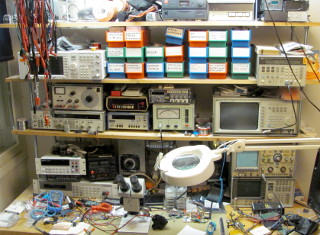
|
This is what my completed workbench looks like, furnished with
all the
necessary junk. There's an ESD mat on the desktop, a couple of
grounded sockets (with the mandatory 1 MΩ resistors)
to connect a wrist strap and other stuff, and a magnifier light is
attached to the edge of the desk.
The threaded rods allow continuous adjustment of the height of each shelf
independently, so I have spaced them according to the height of my
various oscilloscopes, signal generators and other stuff.
|

|
Here's how the threaded rods are joined to the shelves: a hole is
drilled in four corners of each shelf, and a nut and washer go on either
side of it. Likewise I brutally drilled holes through the desktop as well,
and each rod is again locked in place by nuts and washers. Use a drill
bit that's a couple of mm bigger than the rods, and no special care is
needed with measurements. Just make sure the desk's legs, drawers and other
structures don't interfere with the nuts and washers.
When properly tightened up, the thing is just as sturdy as an expensive
Treston electronics workbench, and all my test equipment is conveniently
within reach.
|

|
I even added a cheap fluorescent tube lighting fixture just like the
Trestons have. I raised it higher than the top shelf, so it doesn't
hinder access to it. I did this with slightly thinner threaded rods (M10),
and used lengths of aluminum profile to suspend the light outwards
from the shelves. The profiles are high enough for me not to hit my
forehead on their sharp ends, but easily enough within reach. Therefore
I purposely made them longer than required, so that I can hang test
leads, oscilloscope probes, headphones etc. from them.
|
The result is functional, but not beautiful. Vertical walls on the sides
could be made of thin plywood (they wouldn't need to carry any weight) to
pretty up the thing, but since this is in my own room, the XYL hasn't
complained. A thin plywood "roof" might be good, however, to
reduce the amount of dust settling onto stuff on the top shelf. It would
be supported by the lighting fixture's aluminum profiles, and would also
carry no weight. I must try to get that done some time.


